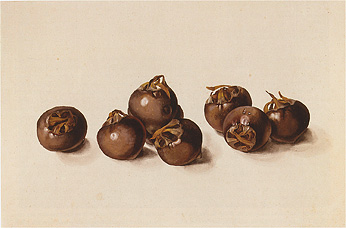
|
|
This study of medlar fruits, seemingly thrown together at random, stands fully in the tradition of scientific nature views that was taught most notably in Weimar since Goethe’s time. The artist, almost unknown despite the signature, shows the medlars in still life-like fashion, in the highest degree of ripeness, on an unelaborated base and with deep shadows that bespeak sunlight filtering in from the left-hand side of the image. No fruit is situated like another, and one recognizes, upon closer inspection, the carefully arranged variations of the individual views. Selectively-placed highlights model the surfaces, and meticulously-analysed irregularities of the original fruits suggest, with fine colour nuances, a trompel’oeil with a totally astonishing, touchable surface.
The rather nondescript medlar fruit was not an unusual motif for nature studies among German-speaking draftsmen. One finds an eye-catching counterpart to this watercolour, for instance, among the works of the brilliant Franz Horny, who was likewise fascinated by these fruits (Fig. 1).
